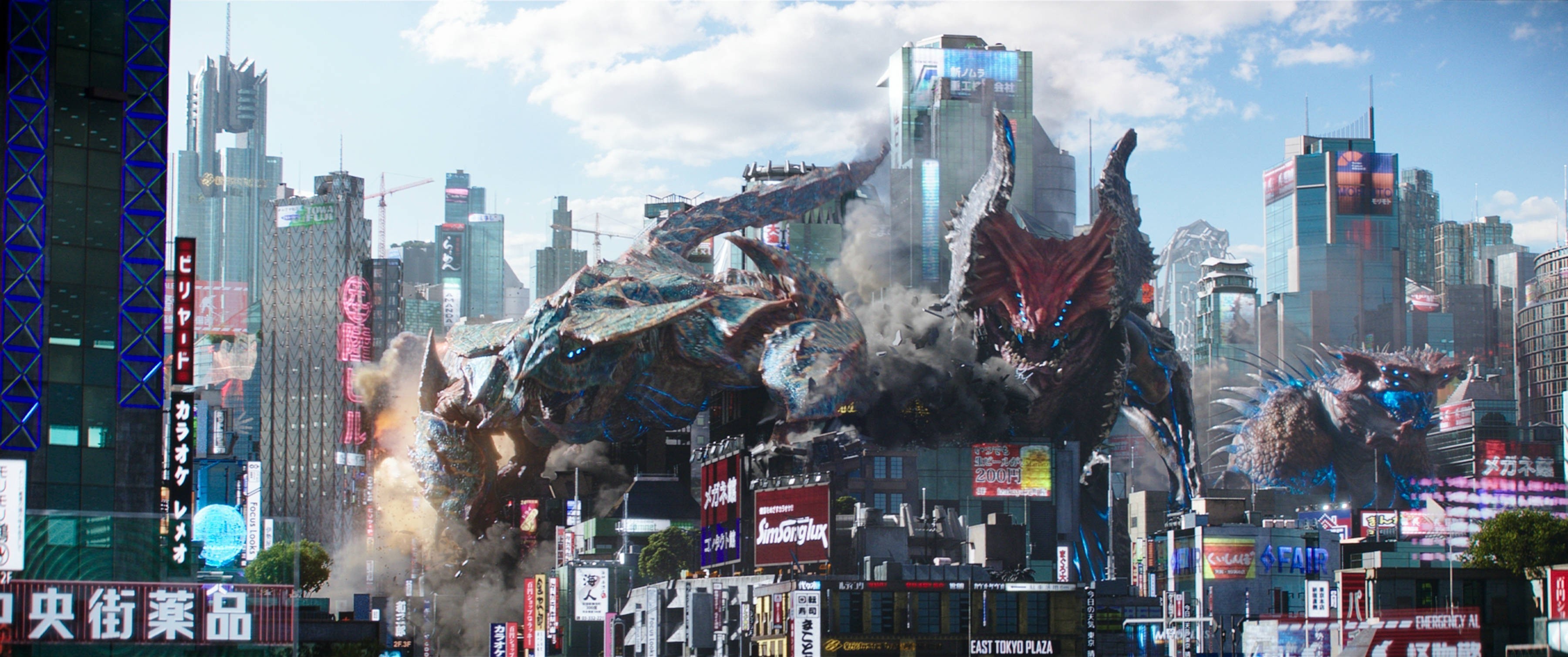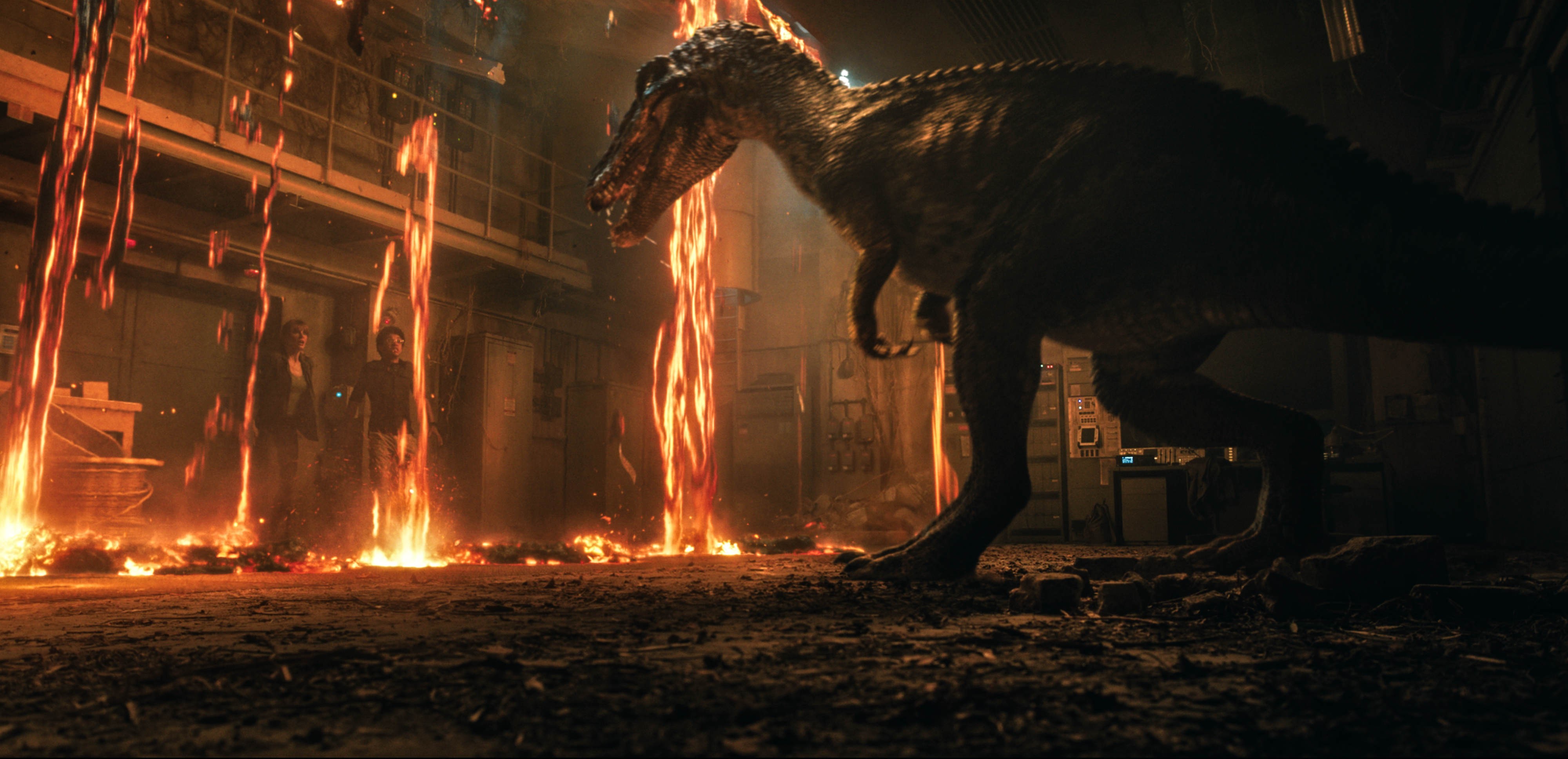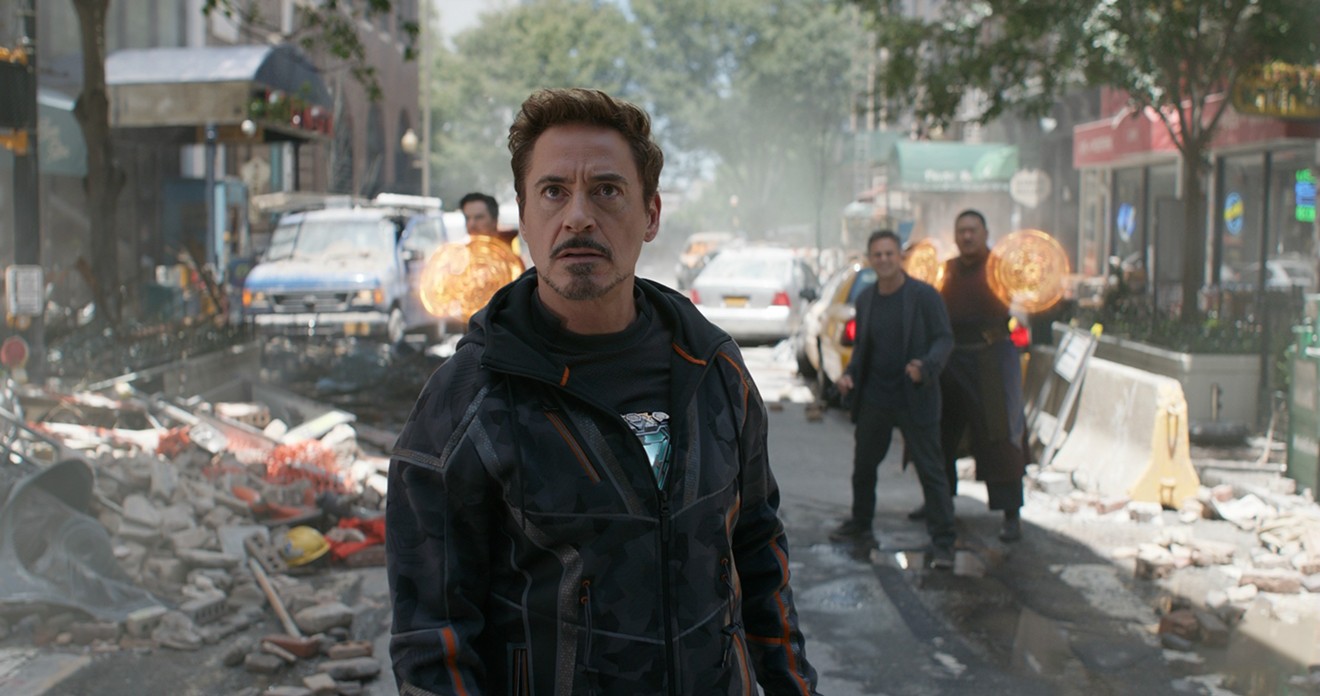Some say we go to the movies to get away from the problems of everyday life. But what do you do when allegedly escapist entertainment traffics in relentless visions of doom and gloom? Just a little over a month ago, I saw alien dinosaur monster thingamabobs lay waste to Tokyo and other cities as they attempted to seize control of the planet in Pacific Rim: Uprising. A few months before that, I witnessed a supervillain try to enslave and replace the Earth, in November’s Justice League. Two X-Men movies ago, an ancient, godlike Egyptian mutant literally named Apocalypse came back and nearly wiped out civilization. The villains of Transformers: The Last Knight wanted to turn our world into the planet Unicron. That was, I think, the third time that someone in the Transformers movies tried to terraform the Earth. Of course, they also tried to do that in Man of Steel, and the first Avengers. By contrast, the bad guy in Avengers: Age of Ultron merely wanted to raise an entire city miles up into the sky so he could drop it down to Earth and destroy all of humanity.
For the moviegoer — or the film critic — who dutifully trudges out to these pictures all year long, the effect is a seemingly endless, soul-eating series of global and cosmic calamities that mostly stopped being bracing or suspenseful or even all that interesting some time ago.
But this is about more than movies. If there’s a boundary in our minds between reality and fiction, visions of cataclysm have begun to obliterate it. Not only are we constantly subjected to end-times scenarios onscreen, we continually face them outside the theater as well — via presidential tweets, responses to presidential tweets, screaming news updates, absolutist language across the world and a constant stream of deeply alarming (and, sadly, often accurate) reporting about all the ways in which our planet and society are totally, irretrievably screwed.
Like I said, I’m tired.

In Pacific Rim: Uprising, alien dinosaur monster thingamabobs lay waste to Tokyo and other cities as they attempt to seize control of the planet.
Courtesy of Universal Studios
Biologically, threatening circumstances lead to the “fight or flight” (or “stress”) response, resulting in the release of hormones that boost our heart rates, dilate our pupils and unleash stored energy. Something similar can happen on a broader, cultural level as well. “Terror Management Theory,” developed by a group of social psychologists in the 1980s, posits that the fear of death can prompt people to act in ways that bind them closer to others with whom they share certain values. As Hans Villarica put it in The Atlantic, it’s to “maintain faith in their own culture’s beliefs and to follow the culture’s paths to an enduring significance that will outlast their own physical death.” That can, of course, be a mixed bag, as it also leads to increased tribalism and heightened prejudice against those who think, look or act differently.
Surely, these are two different things, made-up stories about the apocalypse and actual apocalyptic beliefs or threats? Yes and no. Zacks points to what psychologists call the “sleeper effect,” which posits that exposure to a message, even when you know it’s bogus, can over time still persuade you. The idea was developed during World War II, with draftees who were shown scenes from Frank Capra’s government-financed wartime documentary series Why We Fight. The soldiers were initially highly skeptical of the film, recognizing it as propaganda. When questioned some weeks later, however, they were a lot more convinced of the truth of its message; they had retained the point, but had forgotten its dubious origins.
The sleeper effect points to a potentially troubling truth about the human mind: Our brains have to work harder than we realize to distinguish between fiction and reality. “[William] Wordsworth had this idea that to appreciate literature we had to engage in a willing suspension of disbelief,” Zacks explains. “But it’s actually the opposite: As humans, we have to engage in a willing suspension of belief.” He tells me that as humanity evolved, “we got really good at being able to populate our models of the world with information from disparate sources. I can get a sense of what’s happening around me not just from cues that I observe, but from information you tell me. So, if story-like stuff gets into our brains, we have to treat it as part of the environment. We have to work harder to make it clear to ourselves that it’s fictional. Of course, we can distinguish between reality and a movie — but it’s harder than we realize.”
Does that partly explain my exhaustion? Or the elevated rhetoric we hear on seemingly every issue of controversy? It’s not like I now think that the Battle of Sokovia is a real thing that actually happened or that the armies of Chitauri that invaded New York through a wormhole in Avengers are now part of the historical record. But somewhere, deep in the recesses of my mind, it all contributes to the feeling that I’m living in the midst of an ongoing cataclysm, one in which CGI images of a ruined world have joined forces with constant headlines about rogue nuclear states and a dying planet to feed a sense of numb, dead-eyed helplessness. And, of course, political opportunists can take easy advantage of a population convinced everything’s gotten so bad that they’ve got nothing left to lose.
Cinema’s fondness for the apocalypse has been tracking alongside an increase in such language and imagery in the culture at large. During the closing days of the 2016 election, Vox’s Alissa Wilkinson, co-author of How to Survive the Apocalypse, took a look at the seemingly nonstop cycles of cataclysmic hysteria on both the left and the right. Remember, that was seen as the Flight 93 election by some on the right, the final chance to save a doomed country. Meanwhile, Donald Trump’s unhinged language took the new overstatement to a whole new level. Wilkinson noted that the “apocalyptic tenor… [is] pervasive in American political rhetoric.” It can sometimes even be used for positive ends, since “apocalypse” means more than destruction; Wilkinson points out that it also means “the dismantling of perceived realities — an ending of endings, a shocking tremor of revelation that [remakes] creation in its wake.”

Does the return of dinosaurs, especially a genetically modified one created for Jurassic World, signal the end of the world as we know it?
Courtesy of Universal Pictures, Amblin Entertainment and Legendary Pictures
But over the past couple of decades, this sort of rhetoric has become relentless, finding easy purchase in a culture with a growing fondness for overstatement that’s matched only by its blistering capacity for amplification. McQueen notes that after the attacks of 9/11, George W. Bush became quite fond of apocalyptic rhetoric; in his second inaugural address in 2005, he referred to 9/11 as a “day of fire,” and spoke of the liberating power of “the untamed fire of freedom.” But the “apocalyptic mirror-game,” as the feminist theologian Catherine Keller called it, existed on both the left and the right in the wake of 9/11 — in part because it offered an opportunity to eschew complexity in favor of indignant certainty. Was this terror management kicking in, triaging such energy-depleting things as nuance and humanity in an effort to deal with a perceived existential threat?
As Bush launched multiple wars, our political discourse continued to become a zero-sum game of absolute good and evil, with the fate of the planet and human civilization metaphorically hanging in the balance in every election or policy debate. Since then, the drumbeat of imminent cataclysm has not relented, as everything from the 2008 financial crisis to the rise of ISIS to the Ebola outbreak of 2014-16 has been consumed and processed through the rhetoric of world-ending catastrophe. Overwhelmed by it as we all are, it’s hard sometimes to understand when such fervor is justified. There’s certainly unrelenting real-world horrors on a massive scale: Ebola killed thousands around the world, and would have killed millions more were it not for the heroic efforts of doctors, aid workers and many others. The wars in the Middle East have destroyed cities and upended — and ended — countless lives. Meanwhile, there is a very real chance that the Pacific Northwest will be devastated in our lifetimes by an immense earthquake. And then, you know, there's climate change.
Still, one person’s very real apocalypse is another person’s overreaction: I admit, I did give a bitter chuckle a couple of months ago at an op-ed declaring that apocalyptic language in the gun debate was uncalled for upon seeing that it was written by Michael Gerson. He’s the Bush speechwriter generally credited with the “day of fire” inaugural, as well as some of the former president’s more biblically inflected pronouncements. (For the record, U.S. gun deaths in 2017 claimed five times the number of lives that 9/11 did.)
In some senses, our cultural products are merely reflecting the anxiety of the times. “Hollywood picks up, in a semi-Jungian way, whatever is going on in the culture and transmits it back to us in all kinds of strange scenarios,” says Dr. Harvey Roy Greenberg, a psychoanalyst and journalist, and the author of Screen Memories: Hollywood Cinema on the Psychoanalytic Couch. Obviously, there have been entries in the cataclysmic canon since the dawn of cinema; the 1950s and ’60s saw monster movies that echoed anxieties about the nuclear age in the U.S. and abroad. In the 1990s, advances in computer graphics breathed new life into the disaster movie — especially ones in which the destruction was caused by the vicissitudes of nature (who can forget the competing volcano movies of 1997, Dante’s Peak and Volcano?); the indifferent cruelty of random astronomical phenomena (who can forget the competing asteroid movies of 1998, Armageddon and Deep Impact?); or the nebulous motivations of unfriendly extraterrestrials (who can forget the competing alien invasion movies of 1996, Independence Day and Mars Attacks!?).
Even so, much as it did in the political realm, 9/11 represented a major inflection point in Hollywood’s growing love affair with the apocalypse, as the movies rediscovered the box-office power and cultural impact of evil itself, often abstracted into fantasy or supervillainy. Greenberg evokes the Freudian concept of "narcissistic injury": “We keep ourselves going by our deepest feelings about who we are in the world, and an assault is anything that harms our core belief in who we are — whether it’s the parent who slaps you, or Osama bin Laden. All human development has evolved to protect that sense of self. And 9/11 was a red-hot pipe plunged into the center of the American self.”
I’m dwelling on 9/11 a lot. In many ways, it continues to feed the apocalyptic thinking that has overwhelmed our culture. (The Marvel movies, by the way, understand this; their constant references to “the Battle of New York” from the first Avengers evoke the impact of 9/11.) Maybe because the desert wars never really ended, we never really got the period of pause and reflection that’s required to process all that we’ve lived through. Maybe the imagery just proved too powerful, too profitable, too alluring. In the weeks and months following the terrorist attacks on New York and Washington, D.C., we all wondered how mere entertainment could possibly matter when held up against the horror of that time. And yet, audiences were ready to welcome epic, elemental battles between the forces of light and dark for the fate of the world.
And the movies delivered. Fortuitously, many of the films that would come to rule our future were already waiting in the wings. Peter Jackson’s Lord of the Rings trilogy was starting its rollout, and would soon be garlanded with awards and acclaim, treated with the kind of reverence generally reserved for historical monuments. The first Harry Potter movie would hit in November 2001. Sam Raimi’s Spider-Man, one of the movies to inaugurate the age of the superhero movie, had been shot, but not yet released. (The studio famously erased the image of the World Trade Center from its advertising; I still have an old poster with the Twin Towers reflected in Spidey’s eyes.) Soon, it was all good and evil, and absolutes, and the end of the world — in theaters, on TV, in the papers. And it doesn’t appear to have stopped. None of these film series ended. Even the ones that ended came back. We got three more Hobbit films, and we’re now getting a Lord of the Rings TV show. The Potterverse won’t go away. There are going to be Star Wars movies every year for the rest of our goddamn lives.
I don’t think that we were wrong to have embraced these films. Shared horror like 9/11 does demand metaphors of appropriate immensity, consequence and universality. We escape into fantasy that seems somehow significant. It may well be reflections of a societal “stress response” — humanity as an organism, responding to the threat of collapse by focusing its attention and looking for something greater than itself, which of course includes cultural products.

In X-Men: Apocalypse, Oscar Isaac actually appears as a character named Apocalypse.
Courtesy of Twentieth Century Fox
And what about this issue of terror management? As noted earlier, all that apocalyptic language and rhetoric may well be feeding various bigotries, pushing like toward like, balkanizing our society into warring clusters of cultural uniformity. Not to mention making us susceptible to the cynical promises of demagogues. Scaring the shit out of people is a good way to get them to give up their freedoms, and it’s hard not to feel that the relentless heightened rhetoric all around the world has sent so many democracies willingly drifting into the arms of corrupt, ridiculous strongmen and wannabe savior-gods. And maybe — just maybe — the nagging sense of incipient cataclysm we feel in real life is being fed, albeit subconsciously, by repeated visions of the apocalypse on our screens and elsewhere in our cultural products.
Where does that leave the movies? Beyond the multiplex, some filmmakers are wrestling with the realities of apocalyptic obsession. Paul Schrader’s upcoming First Reformed follows a troubled priest (played by Ethan Hawke) who counsels a young parent-to-be reluctant to bring a child into a fallen, dying world; soon, the priest becomes consumed with the poisoning of the planet. Tense, grim, and electrifying, the film tackles these issues of helplessness, exhaustion and despair head-on — and finds no easy answers. Lynne Ramsay’s You Were Never Really Here also gives us a soul on the edge — an abused man (played by Joaquin Phoenix) who has fought in America’s overseas wars, then served in law enforcement and now works to save kidnapped children from enslavement. The film isn’t ostensibly about any kind of doomsday, and yet, as I watch it, the protagonist’s soul-corroding anxiety and quest for oblivion feels both personal and cultural — an intimate apocalypse of sorts. Both films testify to the fact that movies need not hammer viewers with spectacle to speak to the horror of our times. Meanwhile, Wes Anderson’s Isle of Dogs, for all its cute talking pups, is effectively an allegory of genocide, plague and political calamity.
And believe it or not, for all my cry-uncle exhaustion during Infinity War, I was impressed that the film’s most tragic moments came quietly, mournfully. That gave me momentary hope that even the Marvel movies might be starting to move away from the mind-numbing grandiosity of onscreen devastation. Of course, that’s a silly hope. Loud CGI spectacle is what Hollywood does best, and it’s one of the few things that the global audience still looks to American movies to provide. Besides, there’s a new Jurassic World coming, and the next Avengers has already been shot.
To those of us who grew up during the Cold War, with the ever-present threat of nuclear annihilation hanging over us, fears of the end are nothing new. But when we were presented with images of global calamity during the years it seemed imminent, it rarely felt so casual, disposable. There’s a reason why Dr. Strangelove, Stanley Kubrick’s satire about the end of the world, has endured — it was a chilling, magnificent outlier, an alien presence that dared to laugh at the prospect of humanity getting wiped out. And in so doing, it reinforced the situation’s gravity.
Today, however, references to the end aren’t what we use to convey urgency and gravity; they’re merely part of the landscape now. Meanwhile, competing blockbusters play games of one-upmanship, raising the stakes so that each catastrophe is bigger than the last. But in so doing, they are again merely mirroring the culture at large — a culture in which such language and imagery have been debased. The apocalypse is now a punch line, and a tired one at that.











